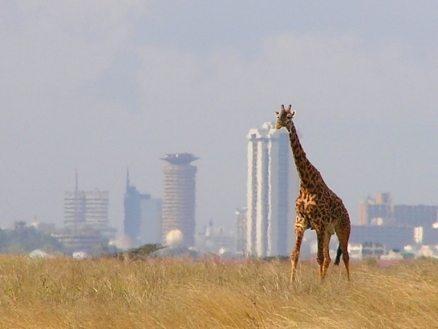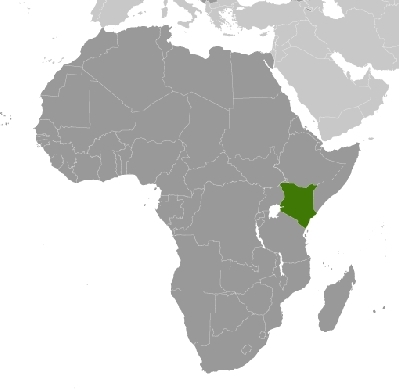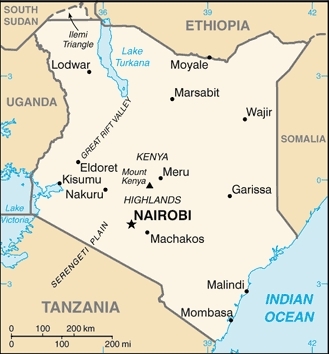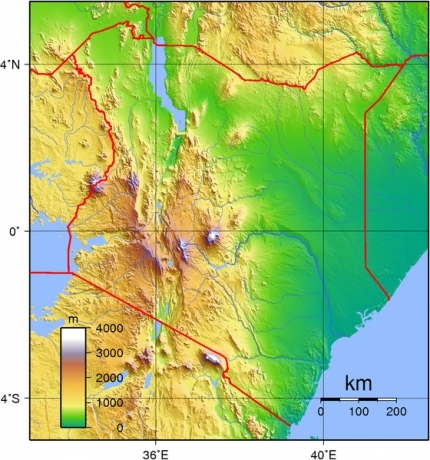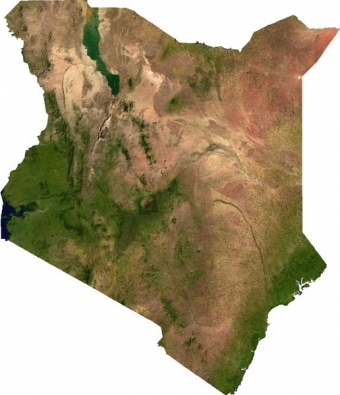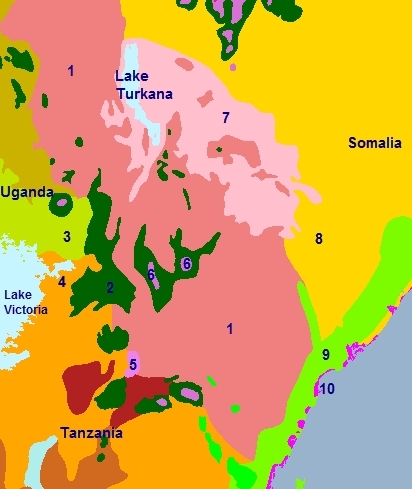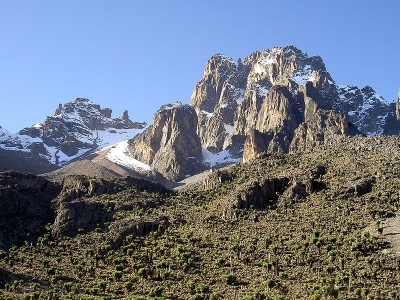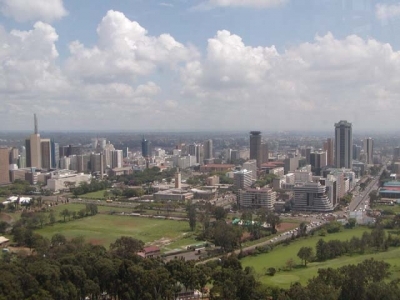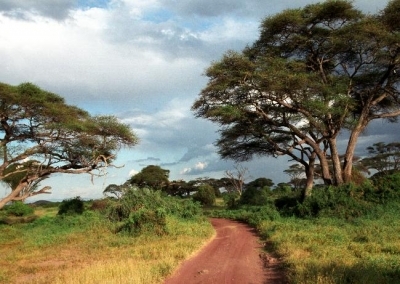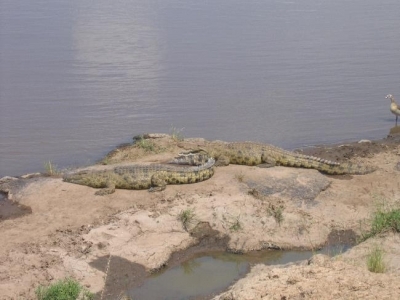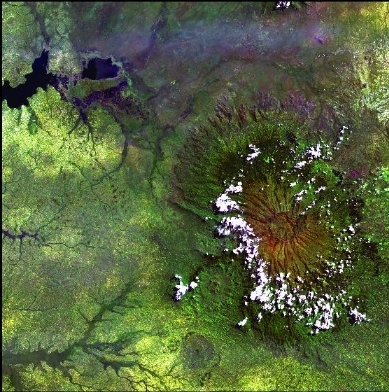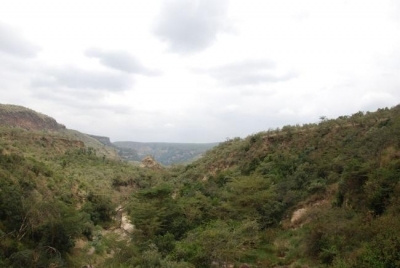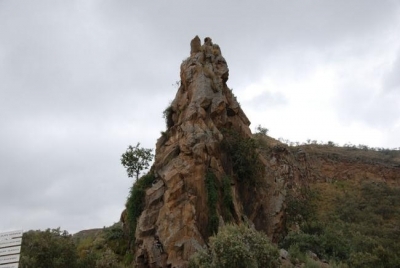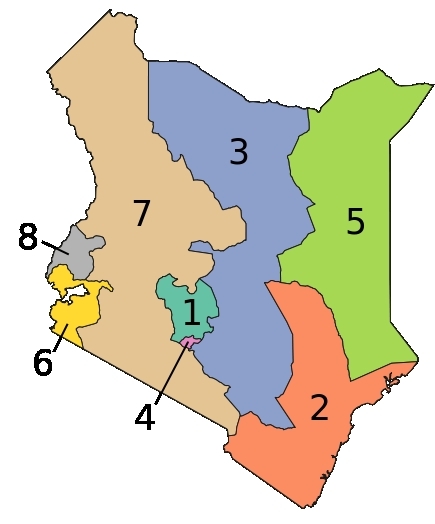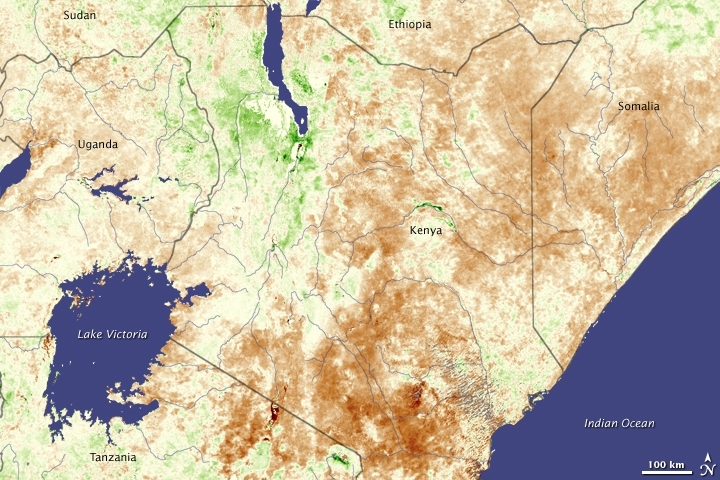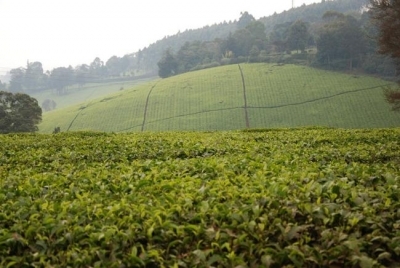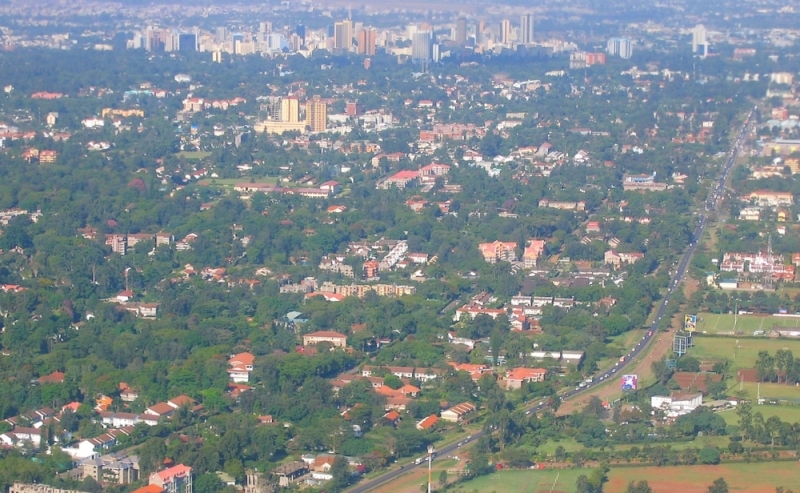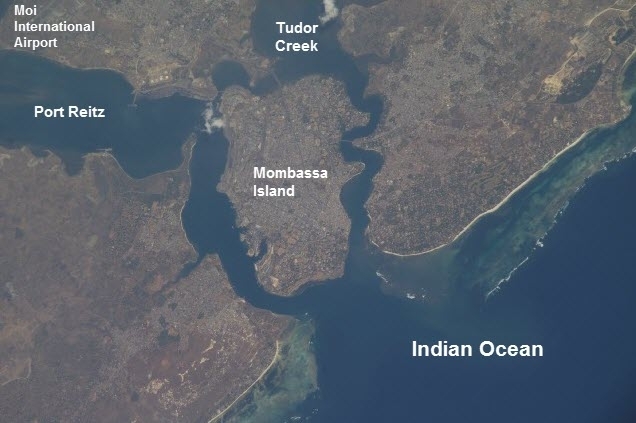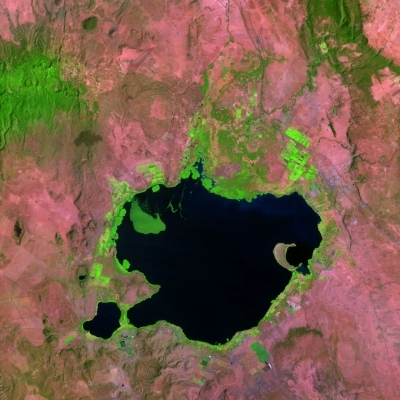Kenya (About the EoE)
Contents
Kenya
Countries and Regions of the World Collection  Kenya is a nation of 43 million people in eastern-Africa, bordering the Indian Ocean, between Somalia and Tanzania. Kenya is dominated by low plains which rise to central Kenyan highlands which are bisected by Great Rift Valley with a fertile plateau in west.
Kenya is a nation of 43 million people in eastern-Africa, bordering the Indian Ocean, between Somalia and Tanzania. Kenya is dominated by low plains which rise to central Kenyan highlands which are bisected by Great Rift Valley with a fertile plateau in west.
The Kenyan Highlands comprise one of the most successful agricultural production regions in Africa.
In the west of the country is Lake Victoria, the source of the Nile River. Glaciers are found on Mount Kenya, Africa's second highest peak. Kenya's unique physiography supports abundant and varied wildlife of scientific and economic value.
Kenya's major environmental issues include:
- water pollution from urban and industrial wastes;
- degradation of water quality from increased use of pesticides and fertilizers;
- water hyacinth infestation in Lake Victoria;
- deforestation;
- soil erosion;
- desertification; and,
- poaching.
It is susceptible to recurring drought; flooding during rainy seasons.
Founding president and liberation struggle icon Jomo Kenyatta led Kenya from independence in 1963 until his death in 1978, when President Daniel Toroitich arap Moi took power in a constitutional succession. The country was a de facto one-party state from 1969 until 1982 when the ruling Kenya African National Union (KANU) made itself the sole legal party in Kenya. Moi acceded to internal and external pressure for political liberalization in late 1991. The ethnically fractured opposition failed to dislodge Kanu from power in elections in 1992 and 1997, which were marred by violence and fraud, but were viewed as having generally reflected the will of the Kenyan people.
President Moi stepped down in December 2002 following fair and peaceful elections.
Mwai Kibaki, running as the candidate of the multiethnic, united opposition group, the National Rainbow Coalition (NARC), defeated Kanu candidate Uhuru Kenyata and assumed the presidency following a campaign centered on an anticorruption platform. Kibaki's NARC coalition splintered in 2005 over the constitutional review process.
Government defectors joined with Kanu to form a new opposition coalition, the Orange Democratic Movement, which defeated the government's draft constitution in a popular referendum in November 2005.
Kibaki's reelection in December 2007 brought charges of vote rigging from ODM candidate Raila Odinga and unleashed two months of violence in which as many as 1,500 people died. UN-sponsored talks in late February produced a powersharing accord bringing Odinga into the government in the restored position of prime minister.
Geography
Location: Eastern Africa, bordering the Indian Ocean, between Somalia and Tanzania
Geographic Coordinates: 1 00 N, 38 00 E
Area: 582,650 km2 (569,250 km2 land and 13,400 km2water)
arable land: 8.01%
permanent crops: 0.97%
other: 91.02% (2005)
Land Boundaries: 3,477 km. Border countries: Ethiopia 861 km, Somalia 682 km, South Sudan 232 km, Tanzania 769 km, Uganda 933 km
Coastline: 536 km
Maritime Claims:
territorial sea: 12 nm
exclusive economic zone: 200 nm
continental shelf: 200 m depth or to the depth of exploitation
Natural Hazards: recurring drought; flooding during rainy seasons
Terrain: Low plains rise to central highlands bisected by Great Rift Valley; fertile plateau in west. Its lowest point is Indian Ocean (0 metres) and its highest point is Mount Kenya (5,199 metres).
Climate: Varies from tropical along coast to arid in interior
|
|
Ecology and Biodiversity
|
1. Northern Acacia-Commiphora bushlands and thickets 2. East African montane forests 3. Victoria Basin forest-savanna mosaic 4. Southern Acacia-Commiphora bushlands thickets 6. East African montane moorlands 7. Masai xeric grasslands and shrublands 8. Somali Acacia-Commiphora bushlands and thickets 9. Northern Zanzibar-Inhambane coastal forest mosaic See also: |
Map source: World Wildlife Fund |
People and Society
Population: 43,013,341 (July 2012 est.)
| Mount Kenya in central Kenya is the highest mountain in country and, aftwr Mount after Kilimanjaro, the second-highest mountain in Africa. Source: Wikimedia Commons. |
| Nairobi. Source: Allan Karuga Wayne/Wikimedia Commons |
| A large herd of elephants makes its way across Amboseli National Park in southern Kenya. Amboseli is generally recognized as the best place in Africa to get close to elephants in their natural surroundings. |
| Distinctive acacia trees line the dirt road carved out by safari vehicles in the Masai Mara National Reserve. Beautiful scenery, gentle rolling grasslands, and an abundance of wildlife define this unique region of the world. |
| Crocodiles along the Mara River. |
| Clouds encircle the lofty rim of Mount Elgon, a huge, long-extinct volcano on the border between Uganda and Kenya, viewed in this enhanced satellite image. The solitary volcano has one of the world's largest intact calderas, a cauldron-like central depression. The caldera is about 6.5 km (4 mi) across and formed following an eruption, when the emptied magma chamber collapsed under the weight of volcanic rock above it. For active volcanoes in Kenya, see the Natural hazards-volcanism subfield in the Geography section. Image courtesy of USGS. |
| A view from inside the Rift Valley. Portions of the Rift Valley have proven to be a rich source of fossils that have enhanced the study of human evolution. |
| Fischer's Tower at the eastern entrance to Hell's Gate Gorge in Hell's Gate National Park. The park is named after a narrow break in some cliffs, the site of a tributary to a prehistoric lake that fed early humans in the Rift Valley. |
Kenya has a very diverse population that includes three of Africa's major sociolinguistic groups: Bantu (67%), Nilotic (30%), and Cushitic (3%). Kenyans are deeply religious. About 80% of Kenyans are Christian, 11% Muslim, and the remainder follow traditional African religions or other faiths. Most city residents retain links with their rural, extended families and leave the city periodically to help work on the family farm. About 75% of the work force is engaged in agriculture, mainly as subsistence farmers. The national motto of Kenya is Harambee, meaning "pull together." In that spirit, volunteers in hundreds of communities build schools, clinics, and other facilities each year and collect funds to send students abroad.
Ethnic Groups: Kikuyu 22%, Luhya 14%, Luo 13%, Kalenjin 12%, Kamba 11%, Kisii 6%, Meru 6%, other African 15%, non-African (Asian, European, and Arab) 1%
Age Structure:
0-14 years: 42.2% (male 8,730,845/female 8,603,270)
15-64 years: 55.1% (male 11,373,997/female 11,260,402)
65 years and over: 2.7% (male 497,389/female 605,031) (2011 est.)
Population Growth Rate: 2.444% (2012 est.)
Birth Rate: 31.93 births/1,000 population (2012 est.)
Death Rate: 7.26 deaths/1,000 population (July 2012 est.)
Net Migration Rate: -0.23 migrant(s)/1,000 population (2012 est.)
Life Expectancy at Birth: 63.07 years
male: 61.62 years
female: 64.55 years (2012 est.)
Total Fertility Rate: 3.98 children born/woman (2012 est.)
Languages: English (official), Kiswahili (official), numerous indigenous languages
Literacy(2003 est.): 85.1% (male: 90.6% - female: 79.7%)
Kenya has six full-pledged public universities: University of Nairobi, Jomo Kenyatta University of Agriculture and Technology, Egerton University, Moi University, Maseno University, Masinde Muliro University (most of these universities also have constituent colleges); and approximately 13 private universities, including United States International University. Public and private universities have a total enrollment of approximately 50,000 students with about 80% of these being enrolled in public universities (representing 25% of students who qualify for university admission). In addition, more than 60,000 students enroll in middle-level colleges where they study career courses leading to certificate, diploma, and higher diploma awards. International universities and colleges have also established campuses in Kenya where students enroll for distance learning and other flexible programs. Other Kenyan students pursue their university education abroad. More than 5,000 Kenyans are studying in the United States.
Urbanization: 22% of total population (2010) growing at a 4.2% annual rate of change (2010-15 est.)
History
Fossils found in East Africa suggest that protohumans roamed the area more than 20 million years ago. Recent finds near Kenya's Lake Turkana indicate that hominids lived in the area 2.6 million years ago.
Cushitic-speaking people from what became Sudan, South Sudan, and Ethiopia moved into the area that is now Kenya beginning around 2000 BC. Arab traders began frequenting the Kenya coast around the first century AD. Kenya's proximity to the Arabian Peninsula invited colonization, and Arab and Persian settlements sprouted along the coast by the eighth century. During the first millennium AD, Nilotic and Bantu peoples moved into the region, and the latter now comprise two thirds of Kenya's population. Swahili, a Bantu language with significant Arabic vocabulary, developed as a trade language for the region.
Arab dominance on the coast was interrupted for about 150 years following the arrival of the Portuguese in 1498. British exploration of East Africa in the mid-1800s eventually led to the establishment of Britain's East African Protectorate in 1895. The Protectorate promoted settlement of the fertile central highlands by Europeans, dispossessing the Kikuyu and others of their land. Some fertile and well watered parts of the Rift Valley inhabited by the Maasai and the western highlands inhabited by the Kalenjin were also handed over to European settlers. For other Kenyan communities, the British presence was slight, especially in the arid northern half of the country. The settlers were allowed a voice in government even before Kenya was officially made a British colony in 1920, but Africans were prohibited from direct political participation until 1944 when a few appointed (but not elected) African representatives were permitted to sit in the legislature.
From 1952 to 1959, Kenya was under a state of emergency arising from the "Mau Mau" insurgency against British colonial rule in general and its land policies in particular. This rebellion took place almost exclusively in the highlands of central Kenya among the Kikuyu people. Tens of thousands of Kikuyu died in the fighting or in the detention camps and restricted villages. British losses were about 650. During this period, African participation in the political process increased rapidly.
The first direct elections for Africans to the Legislative Council took place in 1957. Kenya became independent on December 12, 1963, and the next year joined the Commonwealth. Jomo Kenyatta, an ethnic Kikuyu and head of the Kenya African National Union (KANU), became Kenya's first President. The minority party, Kenya African Democratic Union (KADU), representing a coalition of small ethnic groups that had feared dominance by larger ones, dissolved itself in 1964 and joined KANU.
A small but significant leftist opposition party, the Kenya People's Union (KPU), was formed in 1966, led by Jaramogi Oginga Odinga, a former Vice President and Luo elder. The KPU was banned shortly thereafter, however, and its leader detained. KANU became Kenya's sole political party. At Kenyatta's death in August 1978, Vice President Daniel arap Moi, a Kalenjin from Rift Valley province, became interim President. By October of that year, Moi became President formally after he was elected head of KANU and designated its sole nominee for the presidential election.
In June 1982, the National Assembly amended the constitution, making Kenya officially a one-party state. Two months later, young military officers in league with some opposition elements attempted to overthrow the government in a violent but ultimately unsuccessful coup. In response to street protests and donor pressure, parliament repealed the one-party section of the constitution in December 1991. In 1992, independent Kenya's first multiparty elections were held. Divisions in the opposition contributed to Moi's retention of the presidency in 1992 and again in the 1997 election. Following the 1997 election Kenya experienced its first coalition government as KANU was forced to cobble together a majority by bringing into government a few minor parties.
In October 2002, a coalition of opposition parties formed the National Rainbow Coalition (NARC). In December 2002, the NARC candidate, Mwai Kibaki, was elected the country's third President. President Kibaki received 62% of the vote, and NARC also won 59% of the parliamentary seats. Kibaki, a Kikuyu from Central province, had served as a member of parliament since Kenya's independence in 1963. He served in senior posts in both the Kenyatta and Moi governments, including Vice President and Finance Minister. In 2003, internal conflicts disrupted the NARC government. In 2005 these conflicts came into the open when the government put its draft constitution to a public referendum--key government ministers organized the opposition to the draft constitution, which was defeated soundly. In 2007, two principal leaders of the movement to defeat the draft constitution, Raila Odinga and Kalonzo Musyoka--both former Kibaki allies--were presidential candidates for the Orange Democratic Movement (ODM) party and the Orange Democratic Movement-Kenya (ODM-K) party, respectively. In September 2007, President Kibaki and his allies formed the coalition Party of National Unity (PNU). KANU joined the PNU coalition, although it was serving in parliament as the official opposition party.
On December 27, 2007, Kenya held presidential, parliamentary, and local government elections. While the parliamentary and local government elections were largely credible, the presidential election was seriously flawed, with irregularities in the vote tabulation process as well as turnout in excess of 100% in some constituencies. On December 30, the chairman of the Electoral Commission of Kenya declared incumbent Mwai Kibaki the winner of the presidential election. Violence erupted in different parts of Kenya as supporters of opposition candidate Raila Odinga and supporters of Kibaki clashed with police and each other. The post-election crisis left about 1,300 Kenyans dead and about 500,000 people displaced. In order to resolve the crisis, negotiation teams representing PNU and ODM began talks under the auspices of former UN Secretary General Kofi Annan and the Panel of Eminent African Persons (Benjamin Mkapa of Tanzania and Graca Machel of Mozambique).
On February 28, 2008, President Kibaki and Raila Odinga signed a power-sharing agreement, which provided for the establishment of a prime minister position (to be filled by Odinga) and two deputy prime minister positions, as well as the division of an expanded list of cabinet posts according to the parties' proportional representation in parliament. On March 18, 2008, the Kenyan parliament amended the constitution and adopted legislation to give legal force to the agreement. On April 17, 2008 the new coalition cabinet and Prime Minister Odinga were sworn in. The Kofi Annan-led political settlement also set out a reform agenda to address underlying causes of the post-election violence. The focus is on constitutional, electoral, land, and institutional reform as well as increased accountability for corruption and political violence. The new constitution was approved in a referendum on August 4, 2010.
Government
The unicameral National Assembly consists of 210 members elected to a term of 5 years from single-member constituencies, plus 12 members nominated by political parties on a proportional representation basis. The president appoints the vice president; under the power-sharing agreement, the president with the agreement of the prime minister makes the initial appointment of cabinet members from among those elected to the assembly. Subsequent cabinet appointments are made by the president in consultation with the prime minister, in accord with the power-sharing agreement's proportional division of cabinet positions. The attorney general and the speaker are ex-officio members of the National Assembly.
Government Type: Republic
Capital: Nairobi - 3.375 million (2009)
Other Major Cities: Mombassa 966,000 (2009)
|
Administrative Divisions: Local administration is divided among 140 rural districts, each headed by a commissioner appointed by the president. The districts are joined to form seven rural provinces. Nairobi has special provincial status. The Ministry of State in charge of Provincial Administration and Internal Security supervises the administration of districts and provinces. 7 provinces and 1 area*;
Once implemented, the new constitution will result in significant changes to this structure, including greater devolution of power to 47 counties and creation of a second legislative chamber with responsibility for representing the interests of the counties and regions. Implementation of the new constitution will take several years, but these key changes in the structure of government should be in place in advance of national elections expected to be held in late 2012 or early 2013. |
Map source: Wikimedia Commons |
Independence Date: 12 December 1963 (from UK)
Legal System: Based on Kenyan statutory law, Kenyan and English common law, tribal law, and Islamic law; judicial review in High Court; accepts compulsory ICJ jurisdiction with reservations; constitutional amendment of 1982 making Kenya a de jure one-party state repealed in 1991.
The judiciary consists of a Supreme Court, Court of Appeal, High Court, and Magistrates’ Courts. The Chief Justice is the highest-ranking judicial official. The Supreme Court was established pursuant to the new constitution.
Suffrage: 18 years of age; universal
International environmental Agreements
Kenya is party to international agreements on: Biodiversity, Climate Change, Climate Change-Kyoto Protocol, Desertification, Endangered Species, Hazardous Wastes, Law of the Sea, Marine Dumping, Marine Life Conservation, Ozone Layer Protection, Ship Pollution, Wetlands, and Whaling.
Water
Total Renewable Water Resources: 30.2 cu km (1990)
Freshwater Withdrawal: Total: 1.58 cu km/yr (30% domestic, 6% industrial, 64% agricultural). Per capita: 46 cu m/yr (2000)
Ten million people could face hunger in Kenya after a poor harvest, Kenya’s government warned on January 9, 2009. According to the Associated Press, the government declared a state of emergency to free up funds for food aid.
This image, which shows vegetation conditions between January 1 and January 10, 2009, shows part of the reason for the failed crops. Developing drought settled over eastern Kenya, slowing plant growth. Areas in which plants were growing less vigorously than average are brown, while areas in which plants were growing well are green. Rainfall during the “short rains” season, which typically runs from September or October through November or December, did not provide the moisture maturing crops required in eastern Kenya, and as a result, the end-of-year harvest was poor. By January, shortly after most crops were harvested, the remaining vegetation was clearly in bad shape compared to normal.
In western Kenya, the country’s grain basket, plants were doing well. The region is white and green in this image, indicating that vegetation was either average or healthier and denser than normal. The poor harvest in this region had nothing to do with weather, said the U.S. Department of Agriculture’s Foreign Agricultural Service.
Corn, the primary crop, is typically planted when the long-season rains start between mid-February and mid-April. But in late 2007 and early 2008, post-election violence tore through Kenya, affecting much of the grain basket region. In many regions, farmers evacuated to camps and did not return until late April. By then, it was too late to plant a successful crop, said the Foreign Agricultural Service. Some farmers planted a late corn crop, and others planted wheat instead of corn because wheat has a shorter growing season. Altogether, the season shortened by violence resulted in a smaller harvest in the east, while drought reduced the harvest in the west, said the Foreign Agricultural Service. Source: NASA. Credit: NASA image created by Jesse Allen, using data provided by the United State Department of Agriculture Foreign Agriculture Service and processed by Jennifer Small and Assaf Anyamba, NASA GIMMS Group at Goddard Space Flight Center. Caption by Holli Riebeek with information provided by Assaf Anyamba.
| A view of the Kiambethu tea farm in Limuru in central Kenya on the eastern edge of the Great Rift Valley northwest of Nairobi. |
Agriculture
Agricultural Products: tea, coffee, corn, wheat, sugarcane, fruit, vegetables; dairy products, beef, pork, poultry, eggs
Irrigated Land: 1,030 sq km (2003)
Resources
Natural Resources: limestone, soda ash, salt, gemstones, fluorspar, zinc, diatomite, gypsum, wildlife, hydropower.
Energy
| Energy in Kenya | |||||
| Production | Consumption | Exports | Imports | Reserves | |
| Electricity (2008 est.) |
6.79 billion kWh | 5.738 billion kWh | 41 million kWh | 16 million kWh | |
| Oil | 136 bbl/day (2010 est.) |
78,000 bbl/day (2010 est.) |
8,061 bbl/day (2009 est.) |
80,160 bbl/day (2009 est.) |
0 bbl (1 January 2011 est.) |
| Natural Gas (2009 est.) |
0 cu m |
0 cu m | 0 cu m | 0 cu m | 0 cu m |
| Source: CIA Factbook | |||||
Economy
Although the regional hub for trade and finance in East Africa, Kenya has been hampered by corruption and by reliance upon several primary goods whose prices have remained low. Low infrastructure investment threatens Kenya's long-term position as the largest East African economy.
Kenya is the largest economy in east Africa and is a regional financial and transportation hub. After independence, Kenya promoted rapid economic growth through public investment, encouragement of smallholder agricultural production, and incentives for private (often foreign) industrial investment. Gross domestic product (GDP) grew at an annual average of 6.6% from 1963 to 1973. Agricultural production grew by 4.7% annually during the same period, stimulated by redistributing estates, diffusing new crop strains, and opening new areas to cultivation.
An aerial of the Kenyan capital, Nairob, the central business district and Ngong Road. Source: Wikimedia Commons.
After experiencing moderately high growth rates during the 1960s and 1970s, Kenya's economic performance during the 1980s and 1990s was far below its potential. From 1991 to 1993, Kenya had its worst economic performance since independence. Growth in GDP stagnated, and agricultural production shrank at an annual rate of 3.9%. Inflation reached a record 100% in August 1993. In the mid-1990s, the government implemented economic reform measures to stabilize the economy and restore sustainable growth, including lifting nearly all administrative controls on producer and retail prices, imports, foreign exchange, and grain marketing. Nevertheless, the economy grew by an annual average of only 1.5% between 1997 and 2002, which was below the population growth estimated at 2.5% per annum, leading to a decline in per capita incomes. The poor economic performance was largely due to inappropriate agricultural, land, and industrial policies compounded by poor international terms of trade and governance weaknesses. Increased government intrusion into the private sector and import substitution policies made the manufacturing sector uncompetitive. The policy environment, along with tight import controls and foreign exchange controls, made the domestic environment for investment unattractive for both foreign and domestic investors.
|
Astronaut Photograph of the port of Mombassa. Source: NASA |
The Kenyan Government's failure to meet commitments related to governance led to a stop-start relationship with the International Monetary Fund (IMF) and World Bank, both of which suspended support in 1997 and again in 2001 (when the government failed to institute several anticorruption measures.)
During President Kibaki's first term in office (2003-2007), the Government of Kenya began an ambitious economic reform program and resumed its cooperation with the World Bank and the IMF. There was some movement to reduce corruption in 2003, but the government did not sustain that momentum. Economic growth began to recover in this period, with real GDP growth registering 2.8% in 2003, 4.3% in 2004, 5.8% in 2005, 6.1% in 2006, and 7.0% in 2007. However, the economic effects of the violence that broke out after the December 27, 2007 general election, compounded by drought and the global financial crisis, brought growth down to less than 2% in 2008. In 2009, there was modest improvement with 2.6% growth. GDP growth in 2011 was only 4.3% due to inflationary pressures and sharp currency depreciation - as a result of high food and fuel import prices, a severe drought, and reduced tourism. In accordance with IMF prescriptions, Kenya raised interest rates and increased the cash reserve in November 2011.
In May 2009, the IMF Board approved a disbursement of approximately $200 million under its Exogenous Shock Facility (ESF), which is designed to provide policy support and financial assistance to low-income countries facing exogenous but temporary shocks. The ESF resources were meant to help Kenya recover from the negative impact of higher food and international fuel and fertilizer costs, and the slowdown in external demand associated with the global financial crisis. In January 2011, the IMF approved a 3-year, $508.7-million arrangement for Kenya under the Fund's Extended Credit Facility.
To a considerable extent, the government's ability to stimulate economic demand through fiscal and monetary policy is linked to the pace at which the government is pursuing reforms in other key areas. The Privatization Law was enacted in 2005, but only became operational as of January 1, 2008. Parastatals Kenya Electricity Generating Company (KenGen), Telkom Kenya, and Kenya Re-Insurance have been privatized. The government sold 25% of Safaricom (10 billion shares) in 2008, reducing its share to 35%. Accelerating growth to achieve Kenya's potential and reduce the poverty that afflicts about 46% of its population will require continued deregulation of business, improved delivery of government services, addressing structural reforms, massive investment in new infrastructure (especially roads), reduction of chronic insecurity caused by crime, and improved economic governance generally. The government's Vision 2030 plan calls for these reforms, but realization of the goals could be delayed by coalition politics and line ministries' limited capacity.
Economic expansion is fairly broad-based and is built on a stable macro-environment fostered by government, and the resilience, resourcefulness, and improved confidence of the private sector. Despite the post-election crisis, Nairobi continues to be the primary communication and financial hub of East Africa. It enjoys the region's best transportation linkages, communications infrastructure, and trained personnel, although these advantages are less prominent than in past years.
In FY 2010, tea was Kenya's top export, accounting for $1.15 billion. Fresh horticulture exports were $718 million, well short of the record high of $1.12 billion in 2007, in part due to unfavorable global weather conditions that affected air transportation. Tourism rebounded from the drop experienced in 2008 after the post-election violence, bringing in $807 million in 2009, an increase of 19% from 2008. In 2010, the Kenyan Ministry of Tourism recorded nearly 1.1 million tourists--an all-time high--and an 18% revenue growth, in local currency terms. Africa is Kenya's largest export market, followed by the European Union (EU). Kenya benefits significantly from the African Growth and Opportunity Act (AGOA), but the apparel industry is struggling to hold its ground against Asian competition. Currently there are 19 apparel factories, 1 yarn/fabric company, and 6 accessory companies (labels, sewing supplies, hangers) operating in the Export Processing Zones. Approximately 90% of Kenya's AGOA exports in 2010 were garments, and Kenya’s garment exports under AGOA totaled $202 million in 2010 (a slight increase over 2009 but still well below the 2006 level of $265 million).
|
In southwestern Kenya, northwest of the city of Nairobi, is Lake Naivasha. Naivasha is one of many large and small lakes that occupy eastern Africa’s long Rift Valley, a north-south running depression that has formed where the tectonic plates underlying the continent are pulling away from each other. The freshwater lake occupies a very dry part of the country, and its presence makes possible an agricultural industry focused on fruits, vegetable, vineyards, and more recently, flower cultivation for world markets. The increasing development of the land surrounding the lake is evident in this pair of images from the Landsat satellite from January 1986 (left) and January 2000 (right). Vegetation appears green, bare ground or low vegetation appears in shades of pink. Urban development appears purple, and water appears deep blue. The increase in the size of the city of Naivasha to the northeast of the lake (at about 2 o’clock) is apparent. New development has sprung up in the south and southeast as well, where bright, reflective rooftops glimmer in the sun. More signs of cultivated land are visible, including the eye-catching, pie-chart shaped fields north of Naivasha (see high-resolution image from 2000). This increase in agricultural development, particularly the flower industry is being blamed by many for a rapid decline in water levels in the lake. The lake also experiences wide year-to-year fluctuations in surface area because it is shallow and highly dependent on rainfall. Indeed, the apparent general decrease in “greenness” around the lake’s perimeter in the 2000 image may be linked to year-to-year variability, since much of the surrounding terrain is less green as well. Source: NASA. Credit:Images by Jesse Allen, based on data provided by University of Maryland Global Land Cover Facility | |
Kenya does not systematically collect foreign direct investment (FDI) statistics, and its historical performance in attracting FDI has been relatively weak. The stock of FDI in 2005 was estimated to be about $1.04 billion, less than half of that in neighboring Tanzania. Net foreign direct investment was negative from 2000-2003, but started trickling back in 2004. The stock of U.S. FDI (at historical prices) was estimated to be about U.S. $180 million as of 2010.
Remittances are Kenya’s single largest source of foreign exchange and a key social safety net. According to the Central Bank of Kenya, recorded remittances totaled about $640 million in 2010; however, the actual number may be as high as $1 billion.
Kenya faces profound environmental challenges brought on by high population growth, deforestation, shifting climate patterns, and the overgrazing of cattle in marginal areas in the north and west of the country. Significant portions of the population will continue to require emergency food assistance in the coming years.
Kenya is pursuing regional economic integration, which could enhance long-term growth prospects. The government is pursuing a strategy to reduce unemployment by expanding its manufacturing base to export more value-added goods to the region while enabling Kenya to develop its services hub. In March 1996, the Presidents of Kenya, Tanzania, and Uganda re-established the East African Community (EAC). The EAC's objectives include harmonizing tariffs and customs regimes, free movement of people, and improving regional infrastructures. In March 2004, the three East African countries signed a Customs Union Agreement paving the way for a common market. The Customs Union and a Common External Tariff were established on January 1, 2005, but the EAC countries are still working out exceptions to the tariff. Rwanda and Burundi joined the community in July 2007. In May 2007, during a Common Market for Eastern and Southern Africa (COMESA) summit, 13 heads of state endorsed a move to adopt a COMESA customs union and set December 8, 2008 as the target date for its adoption. On July 1, 2010, the EAC Common Market Protocol, which allows for the free movement of goods and services across the five member states, took effect. In October 2008, the heads of state of EAC, COMESA, and the Southern African Development Community (SADC) agreed to work toward a free trade area among all three economic groups with the eventual goal of establishing a customs union. If realized, the Tripartite Free Trade area would cover 26 countries.
GDP (Purchasing Power Parity): $70.85 billion (2011 est.)
GDP (Official Exchange Rate): $36.1 billion (2011 est.)
GDP- per capita (PPP): $1,700 (2011 est.)
GDP- composition by sector:
agriculture: 19%
industry: 16.4%
services: 64.6% (2011 est.)
Population Below Poverty Line: 50% (2000 est.)
Industries: small-scale consumer goods (plastic, furniture, batteries, textiles, clothing, soap, cigarettes, flour), agricultural products, horticulture, oil refining; aluminum, steel, lead; cement, commercial ship repair, tourism
Exports: tea, horticultural products, coffee, petroleum products, fish, cement
Export Partners: Uganda 16.9%, UK 7%, Tanzania 8.2%, Netherlands 8.1%, US 6.4%, Pakistan 5.2% (2006)
Imports: machinery and transportation equipment, petroleum products, motor vehicles, iron and steel, resins and plastics
Import Partners: UAE 11.4%, China 9.9%, India 8.7%, Saudi Arabia 8%, South Africa 6.3%, US 6.2%, Japan5.9%, UK 4.7% (2006)
Economic Aid Recipient: $768.3 million (2005)
Currency: Kenyan shilling (KES)
Ports and Terminals: Mombasa
